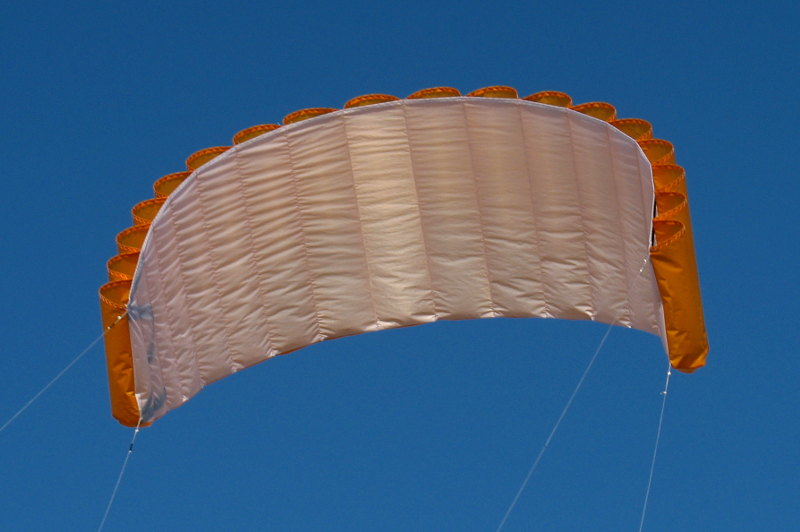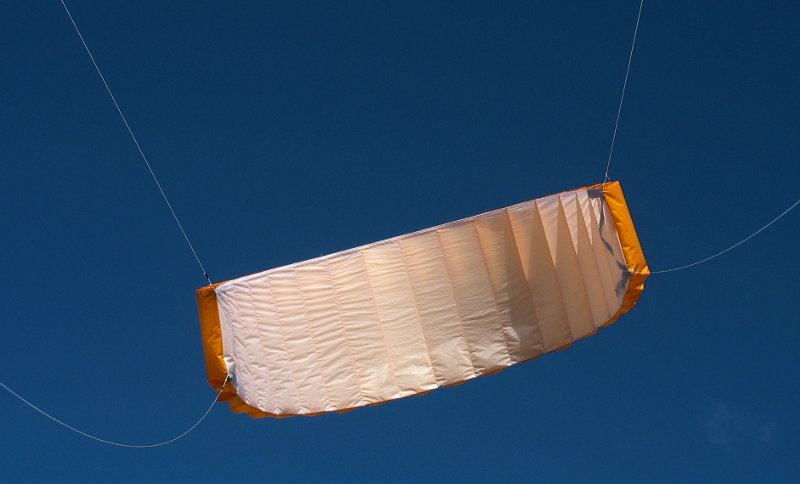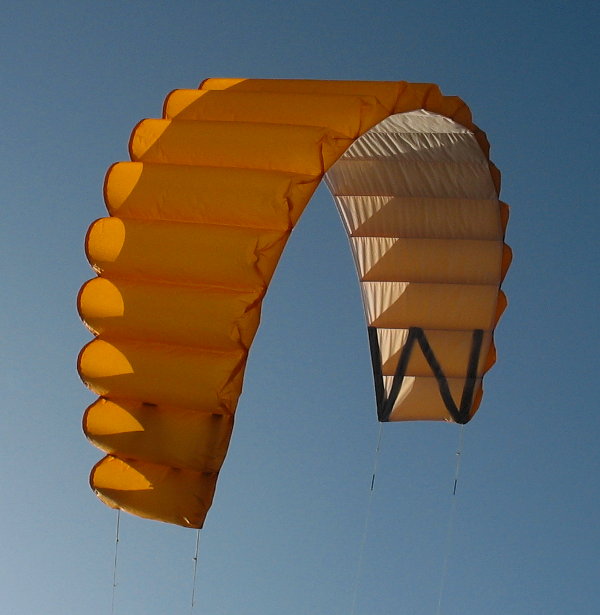
Yagu is ribless two skin sled kite. Similar to a Pan Flute, but span stretched to increase AR. Construction is easy: all sew lines are straight.
18 ram air inflated chambers run from the LE to the TE of the kite. Chambers are longer in the middle of the wing and shorter toward the tips. Each chamber has the same width.
- Flat aspect ratio: 5.4 (using the w2/a formula)
- Area: 0.9 m2
- Tip to Tip: 2.16 m
- Center chord: 0.48 m
Design
The Yagu is based on the experiences of flying FoilNose 3. The main differences between the designs are:
| Chamber Length | Wing Chord Shape | |
|---|---|---|
| FoilNose 3 | LE only | curved |
| Yagu | full chord | flat |
To eliminate spanwise folding as seen in FoilNose 3, I chose to start by running the chambers across the entire surface of the fabric. Many iterations down the road, there will probably be a semi-single skin kite with attributes somewhere between FoilNose 3 and Yagu.
Below is the plan view of the bottom skin of the kite. The LE is the straight bottom line and the TE is the curved top line.

In flight the kite has a flat bottom skin and individual curved sections in the top skin. The majority of bridle forces are concentrated in the bottom skin, so the top skin can be made of a much lighter material.
Let's talk about profile sections for a minute. A profile section is the shape from the LE to the TE when sliced along a chord line. Profile sections and their distribution determine the flying properties of a kite.
Profile Moment
The moment of an airfoil is the twisting force generated by the airfoil as it moves. Profile moment is determined by the camber (the line described by the midpoint of the upper and lower surfaces).A typical airfoil with a positive camber will have a "nose down" twisting force when in flight. A reflex camber (curved "up", at least in the trailing section) is often used because it discourages the kite from luffing. Yagu has a flat camber profile, so no significant moments in either direction should come from profile shape.
Profile Distribution
Profiles can be varied along the span of the kite. For example, a large positive camber can be used in the center to increase lift, and a reflex profile can be used at the wingtips to prevent them from luffing and folding in. However, I believe it is problematic to travel down this road. At least I have a difficult time mentally balancing the forces in a kite when using different profiles in different parts of the span when wind speed is varied. My mental model tells me that [cue "ah-ha moment" music and stroboscopic effects here] what would work well at one wind speed would have totally different characteristics at a different wind speed. The (torque, lift, etc.) responses of differing profiles will scale (with windspeed) at different rates. This may explain why some sleds have a "sweet spot", a wind speed where the performance of the kite suddenly improves.Profile Alignment
Picking a spot on the profile and keeping profiles aligned to that point independent of scaling creates a PAP (profile alignment point). Yagu's PAP is along the leading edge. The affects of varying PAP is discussed in the next section.

Flight Analysis
Above is a bottom front view of Yagu in flight. Wind was blowing 6m/s, so the cells are not pulled taunt. Here we see that there is a slight toe-in to the wing tips. This indicates that the angle of attack at the center of the kite does not match the angle of attack at the wing tips. The center of the kite is operating at too high an angle of attack and the wing tips too low.This next picture shows this difference in attack angles even more clearly. The rear lines must be almost slack for this kite to perform. If this were a single skin kite, this difference in attack angles would probably result in an unflyable kite. Using two skins is more forgiving in this regard, but a designer must look more carefully to see what defects the kite is trying to communicate.

Sled kite AOA indicators can be diagnosed as follows:
- Wing tips stall, center luffs: The PAP is too far back. To fix this, make the LE of the kite more curved, pushing the wingtips back. Or, make the center profiles have a more negative (reflex) camber, inducing "nose up" moment in the center section of the wing.
- Wing tips luff, center stalls: The PAP is too far forward. To fix this, reduce the LE curve, pushing the wingtips forward. Or, make the wingtip profiles have a more negative camber, inducing "nose up" moment in the wing tips.

The picture above shows what happens when over confidence causes me to design a TE closure at the sewing machine. Not too pretty. Next version will use a template to ensure a uniform result. Live and learn! The critical part here is that the top skin is constructed so that it does not tension any part of the bottom skin.

Performance and Closing
The handling of a sled with two full length skins and a single skin kite is quite different. I normally have a conscripted assistant to help me with holding a single skin kite while I adjust bridles, launching, etc. With Yagu, I did all of the handling myself. It seemed much more even tempered and had no desire to slap me in the face with any mis-steps I attempted like the single-skins did.Considering the unequal AOA mentioned above, Yagu flew quite fine. Here is a video of the first flight. It's a 10mb download. For the bandwidth challenged, a lower quality version of the video is available on YouTube.
Since I want to test an improvement to correct the AOA situation, I will not include a complete plan in this article. However, the seriously eager among you will note that the plan for the bottom skin is shown on this page. Using that, and a simple incantation with the constant π, the topskin shape can be determined. Dual skins are quite tolerant: I use π = 3 (just like in Alabama) and am satisfied with the results.
Bonus Section
 Yagu is the Warrungu word for grass. To the left we see Yagu sitting on the grass in single line mode.
Yagu is the Warrungu word for grass. To the left we see Yagu sitting on the grass in single line mode.
Here is a video of single line flight. It's a 5mb download. A smaller, lower quality version of the video is available on YouTube.
Wind was at 4m/s, probably the bottom limit for this small kite. I used bicycle lights as small weights on the rear pig tails to induce stable autozenith behavior. Night flight with blinking bicycle lights is the perfect setup for inducing mass UFO hysteria.
Related pages:
Yagu SLE
Lift to Drag Ratio